Yesterday, the banned and restricted list was updated. Modern was spared, still settling on a new equilibrium after its last bans. Standard has been left alone, which is likely a good move on Wizards’ part—the cures of a banning could well be worse than the symptoms of the disease and it’s worth seeing how Amonkhet changes a rather consistently two-deck Standard. That said, if I were a betting man, come six week’s time I’d really not want to be seen holding any copies of Saheeli Rai, Gideon, Ally of Zendikar, or Heart or Kiran.
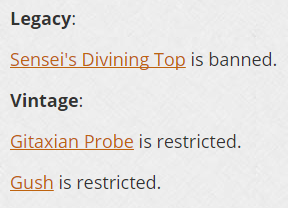
No, this week the eternal formats got some attention from the B&R list, and not the unbanning kind. While I don’t consider myself an expert in Legacy or Vintage (and Hipsters is lucky to have many of those), I do think these bannings tell a good story about Magic design, and in particular, an area Magic is never going to return to.
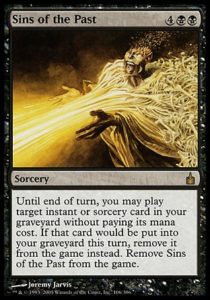 Fool me once…
Fool me once…
Card draw has proven to one of the most powerful things to do in Magic. Make it cheap enough, give it powerful enough selection, make it easy enough to jump through the hoops, make it repeatable, or let it draw enough cards, and you have a broken Magic card. The banned and restricted list is chock full of cards that bend these rules too far:
Modern Banned List
- Dig Through Time
- Gitaxian Probe
- Glimpse of Nature
- Jace, the Mind Sculptor
- Ponder
- Preordain
- Skullclamp
- Treasure Cruise
Legacy Banned List
- Ancestral Recall
- Bazarr of Baghdad
- Dig Through Time
- Frantic Search
- Gush
- Library of Alexandria
- Memory Jar
- Mind`s Desire
- Necropotence
- Skullclamp
- Timetwister
- Treasure Cruise
- Wheel of Fortune
- Windfall
- Yawgmoth`s Bargain
- Yawgmoth`s Will
Vintage Restricted List
- Ancestral Recall
- Brainstorm
- Dig Through Time
- Gitaxian Probe
- Gush
- Library of Alexandria
- Memory Jar
- Merchant Scroll
- Mind`s Desire
- Necropotence
- Ponder
- Timetwister
- Treasure Cruise
- Wheel of Fortune
- Windfall
- Yawgmoth`s Bargain
- Yawgmoth`s Will
So, yeah. Card draw is historically powerful. Bannably powerful. It’s really easy to make it just a little bit too good.
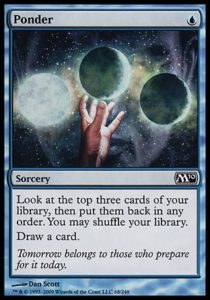
The necessity of randomness
Cards like Sensei’s Divining Top and powerful cantrips like Ponder do something pernicious: they mitigate the inherent randomness of Magic. Now, one may say that this is a great thing, since randomness is the source of all mana flood and the reason the ‘more skilled’ player (which people tend to assume is them) loses.
However, randomness does something incredibly powerful and essential to the game: it creates an exciting moment of uncertainty at the beginning of every player’s turn. Just after you untap your lands, regaining the totality of your resources, you gain a brand new piece of information. Drawing a card feels good. You have something to look forward to every turn. Sure, it could be something you don’t want, but just like when spinning a roulette wheel or asking someone out, it could be exactly what you want. This is a powerful bit of player psychology not done away with lightly, and cards like Top and Courser of Kruphix eliminate it.
Moreover, drawing a card is mindless. That is another word that sounds bad, but is great. Imagine a world where players got to cast Vampiric Tutor every upkeep. Every turn, you have an enormous decision to make, because you have access to the sum totality of your deck. Such a game would heavily skew heavily in favor the better player always winning, since they’d be best able to take process all of that information and make the most correct choice. Such a game would also be far more mentally taxing, far more difficult to learn, and far more frustrating to lose (since so many of your most important decisions were made in isolation from your opponent’s choices and you likely lack the feedback you’d need to learn what your mistakes even worse).
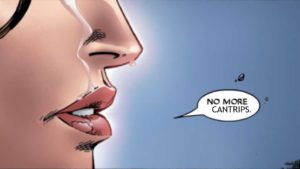
More randomness, more fun
Powerful cantrips and card filtering are bad for Magic and are bad game design. They ruin the joy of drawing a random card. They create a heavy cognitive load which shifts focus from a two player game into two games of solitaire. They become must-includes because of their power and low cost.
It’s not surprising that Wizards hasn’t printed a one mana cantrip (with any kind of card-filtering upside) since 2011’s Ponder. Wizards has instead embraced cards which only filter the cards you draw, like Anticipate, Glimmer of Genius, and Dig Through Time.* Yes, there are also massive draw spells like Pull from Tomorrow and Sphinx`s Revelation, but they cost a large amount of mana (only giving you card advantage for 5+ mana). All of these cards preserve randomness.
* Yes, Ugin`s Insight is a recent card which can filter beyond what it draws, but it’s both a weak draw spell and has a very high setup cost.
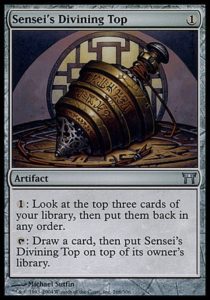
The top tolls for thee
Wizards is not beholden to its past mistakes. Sure, cards like Dig Through Time, Treasure Cruise, and even the humble Gitaxian Probe are bah-roken in nonrotating formats, but they were powerful but fair in their respective Standard formats (which is pretty impressive development). It’s better for Wizards to print such cards and deal with the potential nonrotating fallout than to play it safe. (And I’m saying that as someone who still hasn’t returned to playing Modern since Eldrazi Winter.)
Sometimes it’s not obvious that a card is going to be broken. Living End wasn’t a thing until Alara Reborn introduced cascade to the world. Splinter Twin was a bulk rare until Deceiver Exarch joined it in Standard. Eye of Ugin and Eldrazi Temple weren’t busted until we got 2-5 drop devoid Eldrazi. Gitaxian Probe wasn’t really busted until Khans of Tarkir gave us prowess and new delve spells. Paying two life for Peek isn’t insane by any stretch, but when it adds a mana, creates a token, increases storm, and shaves off two life for Death’s Shadow, it’s suddenly providing way more value than it was ever supposed to.
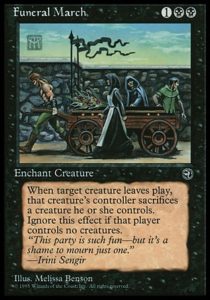
Farewell, likely forever
While I don’t ever see an effect like Sensei’s Divining Top or free card draw like Gitaxian Probe and Gush ever being printed again, my heart goes out to people who owned decks with those cards. It’s disheartening and frustrating enough when one’s $1,000-$2,000 Modern is deck is invalided, as happened from the bans of Splinter Twin and Birthing Pod, but Legacy and Vintage decks exist on a completely different price scale. People play those formats out of love for their cards and nostalgia for their familiar decks (not to mention that the formats are awesome), and being suddenly told that one can no longer play their deck (and the banning of Top invalidates or weakens a lot of decks) is just awful.
While contemporary Magic design can learn from and avoid the mistakes of Magic’s past, eternal Magic has to live with them. Sets like Commander and Conspiracy have proven able to introduce new weapons to older formats while circumventing Standard. It would have been wonderful if another card like Leovold, Emissary of Trest or Sanctum Prelate had been able to tip the scales away from the dominance of Miracles without needing to ban anything, but that’s simply not the world we live in.
Here’s hoping for a new, stable, and banless nonrotating world for a good, long time. Now, Standard on the other hand is likely not escaping this year without at least one more banning. Let’s see when and how that happens come June. Until then, and as always, thanks for reading.
—Zachary Barash
Zachary Barash is a New York City-based game designer. He learned Magic in 1994 and is still afraid of Living Wall (don’t click it! It’ll see you!). He’s currently pursuing his MFA in Game Design at NYU and designing for Kingdom Death: Monster. His favorite card of the month is Spell Snare, a counterspell which trades efficiently on mana but only in an extremely limited situation. Also, it’s a counterspell that can’t counter itself, and that’s just nice.

